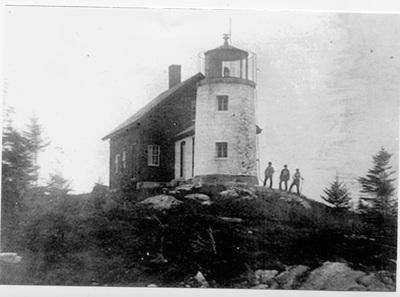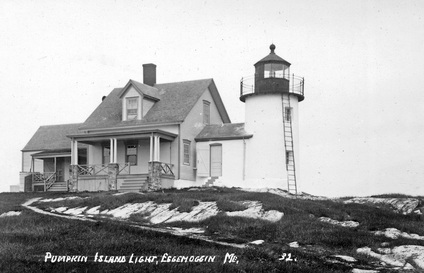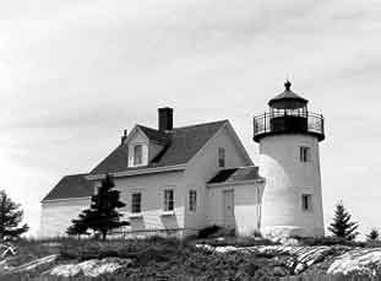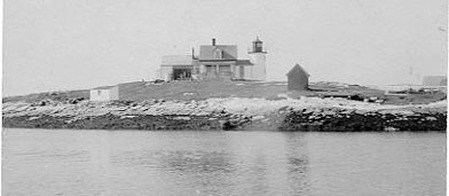History of Pumpkin Island Light, Little Deer Isle, Maine
Click here for a gallery of Pumpkin Island Light photos on SmugMug (prints and gift items available)
From the entrance [of Eggemoggin Reach] at Pumpkin Island out again at the Devil's Head, no sail could be more charmingly diversified, more full of scenic surprises, or more free from actual or hidden dangers. One cannot look in any direction without seeing some new picture. -- Samuel Adams Drake, The Pine Tree Coast, 1891.

Circa 1859 (National Archives)
Pumpkin Island is on the south side of the northwestern entrance to Eggemoggin Reach, a narrow channel that separates the mainland from Deer Isle and Little Deer Isle, stretching about 11 miles from Cape Rosier at the northwest to Naskeag Point at the southeast. The reach provides passage from Penobscot Bay to Jericho Bay and Blue Hill Bay.
In the nineteenth century, this area was heavily traveled by vessels carrying lumber and later by summer pleasure craft. The name of the reach was once spelled Algemogin, and it’s said to be derived from a local Indian word meaning “place of the great fish weir.”
An 1852 report of the United States Coast Survey pointed out the importance of Eggemoggin Reach: “This passage, although not so much used as the Muscle Ridge channel, is nearly as useful to commerce, and would be more so were there guides for entering it at night.”
Congress appropriated $3,500 for a light station on Pumpkin Island in August 1852.
In the nineteenth century, this area was heavily traveled by vessels carrying lumber and later by summer pleasure craft. The name of the reach was once spelled Algemogin, and it’s said to be derived from a local Indian word meaning “place of the great fish weir.”
An 1852 report of the United States Coast Survey pointed out the importance of Eggemoggin Reach: “This passage, although not so much used as the Muscle Ridge channel, is nearly as useful to commerce, and would be more so were there guides for entering it at night.”
Congress appropriated $3,500 for a light station on Pumpkin Island in August 1852.
The light went into service on January 1, 1855, its focal plane 27 feet above mean high water.

The station consists of a round brick tower, 17 feet tall to the lantern deck, and a one-and-one-half-story colonial Cape dwelling, attached to the tower by a work shed.
The lantern held a fifth-order Fresnel lens, one of the earliest Fresnel lenses used in a Maine lighthouse. In 1889, the lighthouse was fitted with a new lantern, which increased its height by three feet.
The first keeper—at $350 yearly—was John Chester Tibbetts, the same man who had sold the island to the government. He stayed until 1861. Tibbets, a native of nearby Brooklin, went to sea as a young man and captained vessels by the age of 30. After his lightkeeping days, Tibbetts ran a store in Brooklin, where he also served as postmaster and as deacon of the Baptist church.
The lantern held a fifth-order Fresnel lens, one of the earliest Fresnel lenses used in a Maine lighthouse. In 1889, the lighthouse was fitted with a new lantern, which increased its height by three feet.
The first keeper—at $350 yearly—was John Chester Tibbetts, the same man who had sold the island to the government. He stayed until 1861. Tibbets, a native of nearby Brooklin, went to sea as a young man and captained vessels by the age of 30. After his lightkeeping days, Tibbetts ran a store in Brooklin, where he also served as postmaster and as deacon of the Baptist church.
Charles Leroy Babson, a native of nearby Brooklin, was keeper from 1870 to 1902. Babson had served in the Civil War and received a gunshot wound at the Battle of Fredericksburg that had led to the amputation of his left leg.

U.S. Coast Guard photo
Babson and his wife, Georgianna (Herrick), had two children when they moved to Pumpkin Island, and another son was born in 1872. Babson eventually bought a large tract of land on Little Deer Isle, opposite the lighthouse. A dining hall and a few cottages were built, and the Eggemoggin summer colony was born.
Before long, many more cottages were built. Captain Babson, as he was known, was described as a tall, dignified man who was kind and gracious to everyone. He always walked with the help of a cane.
According to a family descendant, the Babsons’ niece Josephine Herrick sometimes tended the light when the keeper was away. Babson’s health began to fail after 32 years on Pumpkin Island, and he retired to a home on the mainland in Sargentville. In 1915, when he and Georgianna celebrated their golden wedding anniversary, one of their gifts was a gold case containing $1,000 from their former summer boarders.
Before long, many more cottages were built. Captain Babson, as he was known, was described as a tall, dignified man who was kind and gracious to everyone. He always walked with the help of a cane.
According to a family descendant, the Babsons’ niece Josephine Herrick sometimes tended the light when the keeper was away. Babson’s health began to fail after 32 years on Pumpkin Island, and he retired to a home on the mainland in Sargentville. In 1915, when he and Georgianna celebrated their golden wedding anniversary, one of their gifts was a gold case containing $1,000 from their former summer boarders.
The light was discontinued and the station was destaffed in 1933.

In 1934, Pumpkin Island Light was one of several of Maine lighthouses that were discontinued and put up for auction by the government. George Harmon of Bar Harbor bought the station along with two others. Since then the island has passed through several private owners.
An automatic beacon near Pumpkin Island continues today as an aid to navigation. You can get a good view by turning right on Eggemoggin Road just after crossing the bridge from the north to Little Deer Isle and continuing to the end.
Some of the schooners out of Rockland, Rockport, and Camden occasionally pass nearby.
An automatic beacon near Pumpkin Island continues today as an aid to navigation. You can get a good view by turning right on Eggemoggin Road just after crossing the bridge from the north to Little Deer Isle and continuing to the end.
Some of the schooners out of Rockland, Rockport, and Camden occasionally pass nearby.
Keepers: (This list is a work in progress. If you have any information on the keepers of this lighthouse, I'd love to hear from you. You can email me at [email protected]. Anyone copying this list onto another web site does so at their own risk, as the list is always subject to updates and corrections.)
John Chester Tibbetts (1854-1861); J. G. Walker (1861-1864); Joshua Snow (1864-1870); Charles L. Babson (1870-1902); Charles H. Newman (c. 1920s); F. A. Rumery (?-1933)
John Chester Tibbetts (1854-1861); J. G. Walker (1861-1864); Joshua Snow (1864-1870); Charles L. Babson (1870-1902); Charles H. Newman (c. 1920s); F. A. Rumery (?-1933)